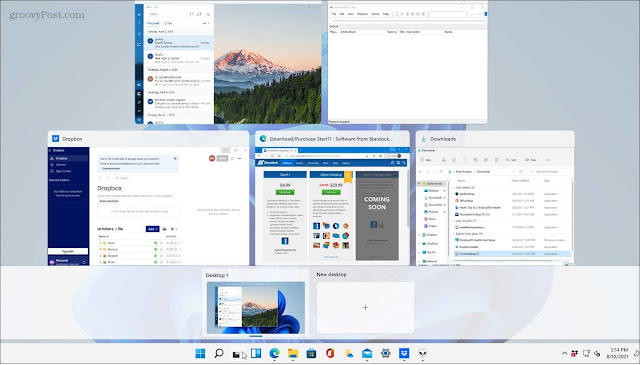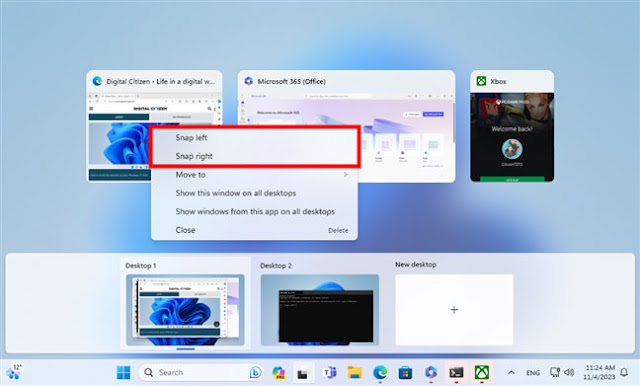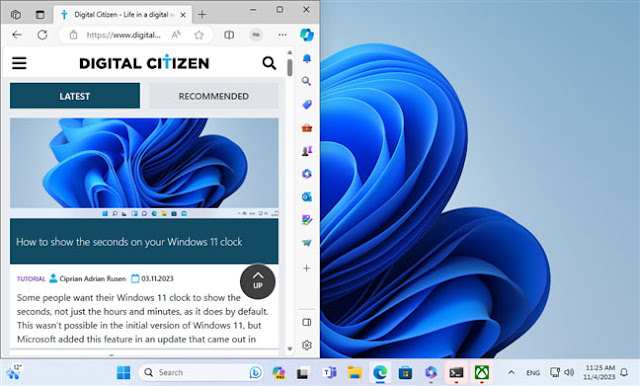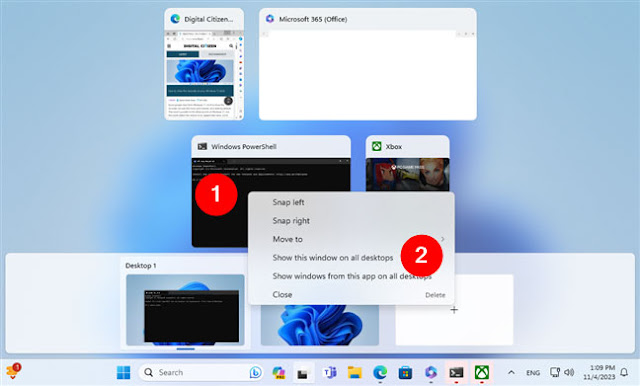Windows 11's Task View is a powerful feature that allows you to manage multiple application windows on different virtual desktops. With it, you can organize your work into separate categories and also switch between them easily. Today's article will tell you what Task View is, how to access it with the dedicated Taskbar button, and how to open Task View with a keyboard shortcut. The article will also show you how to use Task View to increase productivity in Windows 11.
What is Task View in Windows 11?
Task View is a feature introduced with Windows 10, also present in Windows 11, designed to enhance multitasking. It allows you to access and organize your open applications and windows. This also includes workspaces found on multiple virtual desktops, which are separate workspaces that you can create and switch between.
If you've used Windows 10, you may remember that you can also use Task View to continue previous activities you started on any device connected to your Microsoft account, such as such as browsing a website or editing a document. In Windows 11, Task View no longer includes a Timeline, instead focusing on giving you quick and easy access to open applications and virtual desktops.
I. How to open Task View in Windows 11
Now, you know that the Task View screen allows you to view and manage your open windows and virtual desktops. But how do you access it? There are two methods and both are quite simple:
1. How to open Task View from Windows 11 Taskbar
You can find the Task View button on the Taskbar. It's right next to Windows Copilot or the search field on your Taskbar. The Task View icon shows two rectangles (black and white) stacked on top of each other. To open Task View, just click or tap this button.
This immediately causes Windows 11 to display the Task View interface, where you can view and manage your virtual windows and desktops.
If you don't see Task View on the Windows 11 Taskbar, you need to make sure this button is turned on. In some cases, this button may be hidden or disabled but you can enable it easily by following these steps:
Find an empty space on the Taskbar and right-click on it. Alternatively, you can long press on the Taskbar if you are using a touchscreen device. A menu will appear with two options: Task Manager and Taskbar Settings. Click Taskbar Settings to access Taskbar customization settings.
This will open the Settings app on the Personalization > Taskbar page. Here, look for the option called Task View and toggle the switch to the right.
The Task View button will now appear on the Taskbar, next to the search box or the Windows Copilot icon.
2. How to open Task View with keyboard shortcuts
Windows 11 also allows you to access Task View using just the keyboard. In case you are wondering what the shortcut is to open Task View in Windows 11, it is: Win + Tab
Just press and hold the Windows key and then press the Tab key on your keyboard. Just like using the Task View shortcut on the Taskbar, this shortcut will display the Task View screen, where you can see all your windows and desktop in thumbnail view.
II. How to use Task View in Windows 11
The main purpose of Task View is to allow you to get a quick overview of open applications and easily switch between them. When you open Task View, you'll see thumbnail previews of all your open windows as well as all the virtual desktops you've created on your Windows 11 computer.
1. How to use Task View in Windows 11 to focus on an application
To select the window you want to work with, you can use your mouse to click on it, or just tap it if you have a touch screen.
Additionally, if you prefer using a keyboard over a mouse or touchscreen, you can press the arrow keys on your keyboard to move the marker through the app. Once the window you need is highlighted, press Enter on your keyboard to focus on that window.
2. How to use Task View in Windows 11 to switch between virtual desktops
Virtual Desktop is a feature of Windows 11 that allows you to create and manage multiple workspaces on your computer. Each virtual desktop can have its own set of open applications and windows, which you can switch between using the Task View screen. This can help you multitask more effectively because you can dedicate each screen to a specific task or purpose.
For example, you can have a virtual desktop for your personal activities, such as browsing social networks and chatting with friends, as well as another desktop for projects at work or school, where you have all the documents and tools you need. By using a virtual desktop, you can reduce clutter and distractions on your screen and better focus on the task at hand. Virtual desktops are a great way to increase your productivity in Windows 11. If you want to know more about how to use them, you should read the guide: How to use virtual desktops on Windows 11.
To switch between different virtual desktops and access their open windows, move the mouse pointer over the desktop you want to view. This will give you a preview of the open application windows on that screen. You can then select the window you want to work with by clicking or tapping it.
This way, you can easily switch to any open application, even if you're using multiple virtual environments on your Windows 11 computer.
3. How to position windows and split the screen using Task View
Task View also allows you to easily arrange your windows on the current screen by dragging them to the left or right side of the screen. To use this feature, on the Task View screen, you need to right-click or press and hold on the window you want to locate. Then, select Snap left or Snap right from the context menu, depending on your preference.
This will resize and position the window to take up half the screen, leaving the other half for another window.
4. How to use Task View to move applications to another virtual desktop
Windows 11's Task View also allows you to move applications from one virtual desktop to another. To do that, you can drag and drop its thumbnail from the current desktop to the desired desktop.
You can also right-click on the application thumbnail and select Move to > Desktop X, where X is the virtual desktop number.
5. How to use Task View to display windows on every desktop
To show an application's window on all of your virtual desktops, in Task View, right-click the application's thumbnail and select Show this window on all desktops. This will make that window show up on every virtual desktop you switch to.
To show all windows of a given application on all your virtual desktops, the process is similar: Right-click the application thumbnail in Task View and select Show windows from this app on all desktops.
III. How to close applications from Task View
If you want to close an application while in Task View, hover over the application. You'll see a small X icon in the upper right corner of the app's thumbnail. Click the X button to close the application.
You can also right-click on the application thumbnail and select Close from the context menu.
However, be careful not to close any applications that you are still using or that contain unsaved work. This may lead to unwanted data loss.
Conclusion:
This post describes Task View and how to use it in Windows 11. If you find any errors above, please use the comments form below to report it.





























No comments:
Post a Comment